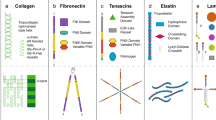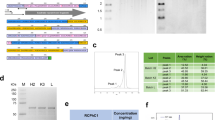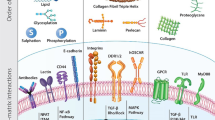Abstract
Synthetic polymer scaffolds designed for cell transplantation were reproducibly made on a large scale and studied with respect to biocompatibility, structure and biodegradation rate. Polyglycolic acid (PGA) was extruded and oriented to form 13 μm diameter fibers with desired tenacity. Textile processing techniques were used to produce fibrous scaffolds with a porosity of 97% and sufficient structural integrity to maintain their dimensions when seeded with isolated cartilage cells (chondrocytes) and cultured in vitro at 37°C for 8 weeks. Cartilaginous tissue consisting of glycosaminoglycan and collagen was regenerated in the shape of the original PGA scaffold. The resulting cell-polymer constructs were the largest grown in vitro to date (1 cm diameter × 0.35 cm thick). Construct mass was accurately predicted by accounting for accumulation of tissue components and scaffold degradation. The scaffold induced chondrocyte differentiation with respect to morphology and phenotype and represents a model cell culture substrate that may be useful for a variety of tissue engineering applications.
This is a preview of subscription content, access via your institution
Access options
Subscribe to this journal
Receive 12 print issues and online access
$209.00 per year
only $17.42 per issue
Buy this article
- Purchase on Springer Link
- Instant access to full article PDF
Prices may be subject to local taxes which are calculated during checkout
Similar content being viewed by others
References
Langer, R. and Vacanti, J.P. 1993. Tissue Engineering. Science 260: 920–926.
Lanzetta, M. and Ower, E. 1992. Achieving better patency rates and neoendothelialization in 1-millimeter polytetrafluoroethylene grafts by varying fibril length and wall thickness. Microsurg. 13: 76–83.
Golden, M.A., Hanson, S.R., Kirkman, T.R., Schneider, P.A. and Clowes, A.W. 1990. Healing of polytetrafluoroethylene arterial grafts is influenced by graft porosity. J Vasc. Surg. 11: 838–845.
Freed, L.E., Marquis, J.C., Nohria, A., Emmanual, J., Mikos, A.G. and Langer, R. 1993. Neocartilage formation in vitro and in vivo using cells cultured on synthetic biodegradable polymers. J. Biomed. Mater. Res. 27: 11–23.
Freed, L.E., Marquis, J.C., Vunjak-Novakovic, G., Emmanual, J. and Langer, R. 1994. Composition of cell-polymer cartilage implants. Biotech & Bioeng. 43: 605–614.
Freed, L.E., Grande, D.A., Emmanual, J., Marquis, J.C., Lingbin, Z. and Langer, R. 1994. Joint resurfacing using allograft chondrocytes and synthetic biodegradable polymer scaffolds. J. Biomed. Mater. Res. Vol. 28 (In press).
Vacanti, C., Langer, R., Schloo, B. and Vacanti, J.P. 1991. Synthetic biodegradable polymers seeded with chondrocytes provide a template for new cartilage formation in vivo. Plastic and Reconstr. Surg. 88: 753–759.
Cima, L.G., Vacanti, J.P., Vacanti, C., Ingber, D., Mooney, D. and Langer, R. 1991. Tissue engineering by cell transplantation using degradable polymer substrates. J. Biomechanical Engineering 113: 143–151.
Uyama, S., Takeda, T. and Vacanti, J.P. 1993. Delivery of a whole liver equivalent hepatic mass using polymer devices and hepatotrophic stimulation. Transplantation 55: 932–935.
Mooney, D.J., Organ, G., Vacanti, J.P. and Langer, R. 1994. Design and fabrication of biodegradable polymer devices to engineer tubular tissues. Cell Transplantation. 3: 203–210.
Gristina, A.G. 1987. Biomaterial-centered infection: microbial adhesion versus tissue integration. Science 237: 1588–1595.
Frazza, E.J. and Schmitt, E.E. 1971. A mew absorbable suture. J. Biomed. Mater. Res. Symp. 1: 43–58.
Freed, L.E., Vunjak-Novakovic, G. and Langer, R. 1993. Cultivation of cell-polymer cartilage implants in bioreactors. J. Cell. Biochem. 51: 257–264.
Freed, L.E., Vunjak-Novakovic, G., Marquis, J.C. and Langer, R. 1994. Kinetics of chondrocyte growth in Cell-polymer implants. Biotech & Bioeng. 43: 597–604.
Gilding, D.K. and Reed, A.M. 1979. Biodegradable polymers for use in surgery polyglycolic/polylactic acid homo-and copolymers. Polymer 20: 1459–1464.
Cohn, D., Younes, H. and Marom, G. 1987. Amorphous and crystalline morphologies in glycolic acid and lactic acid polymers. Polymer 28: 2018–2022.
Pellegrini, V.D. 1991. Osteoarthritis of the thumb trapeziometacarpal joint: A study of the pathophysiology of articular cartilage degeneration. I. Anatomy and pathology of the aging joint, and II. Articular wear patterns in the osteoarthritic joint. J. Hand Surg. 16A: 967–982.
Craig, P.H., Williams, J.A., Davis, K.W., Magoun, A.D., Levy, A.J., Bogdansky, S. and Jones, J.P. 1975. A biologic comparison of polyglactin 910 and polyglycolic acid synthetic absorbable sutures. Surg. Gyn. & Obstet. 141 1–10.
Benicewicz, B.C. and Hopper, P.K. 1990. Polymers for absorbable surgical sutures, J. Bioactive and Compatible Polymers 5: 453–472.
Freshney, R.I. 1987. Culture of Animal cells, 2nd Ed., p. 232. Wiley-Liss, New York.
Kronenthal, R.L. 1975. Biodegradable polymers in medicine and surgery, p. 118–137. In: Polymers in Medicine and Surgery, Plenum Press, NY.
Chu, C.C. 1981. The in vitro degradation of polyglycolic acid sutures-effect of pH. J. Biomed. Mater. Res. 15: 795–804.
Zhang, X., Goosen, M.F.A., Wyss, U.P. and Pichora, D. 1993. Biodegradable polymers for orthopedic applications. J. Macromol. Sci. Rev. Macromol. Chem. Phys. C33: 81–102.
Singhal, J.P., Singh, H. and Ray, A.R. 1988. Absorbable suture materials, preparation and properties J. Macromol. Sci. Rev. Macromol. Chem. Phys. C28: 475–502.
Williams, D.F. and Mort, E. 1977. Enzyme accelerated hydrolysis of PGA. J. Bioengineering 1: 231–238.
Williams, D.F. 1980. Effect of bacteria on absorbable sutures. J. Biomed. Mater. Res. 14: 329–338.
Freed, L.E. and Vunjak-Novakovic, G. 1994. Hydrodynamic forces determine in vitro chondrogenesis in a three-dimensional cell-polymer model system. Biotech. & Bioeng. Submitted.
Ingber, D.E., Dike, L., Hansen, L., Karp, S., Liley, H., Maniotis, A., McNamee, H., Mooney, D., Plopper, G., Sims, H. and Wang, N. 1994. Cellular tensegrity: exploring how mechanical changes in the cytoskeleton regulate cell growth, migration, and tissue pattern during morphogenesis. Int. Rev. Cyt. 150: 173–224.
Daniels, K. and Solursh, M. 1991. Modulation of chondrogenesis by the cytoskeleton and extracellular matrix. J. Cell Sci. 100: 249–254.
Benya, P.D. and Brown, P.D. 1986. Modulation of chondrocyte phenotype in vitro, p. 219–233. In: Articular Cartilage Biochemistry. K. E. Kuettner, R. Schleyerbach, and V. C. Hascall (Eds.). Raven Press, New York.
Glowacki, J., Trepman and E., Folkman, J. 1983. Cell shape and phenotypic expression in chondrocytes. Proc. Soc. Exp. Biol. Med. 172: 93–98.
Wang, N., Butler, J.P. and Ingber, D.E., 1993. Mechanotransduction across the Cell surface and through the cytoskeleton Science 260: 1124–1127.
Thompson, D.W. 1977. On Growth and Form, Ch. 8, p. 221–267. Cambridge University Press, New York.
Folkman, J. and Mascona, A. 1978. Role of Cell shape in growth control. Nature 273: 345–349.
Watt, F. 1986. The extracellular matrix and cell shape. Trends in Biochem. Sci. 11: 482–485.
Kim, Y.J., San, R.L., Doong, J.Y.H. and Grodzinsky, A.J. 1988. Fluorometric assay of DNA in cartilage explants using Hoechst 33258. Anal. Biochem. 174: 168–176.
Farndale, R.W., Buttle, D.J. and Barrett, A.J. 1986. Improved quantitation and discrimination of sulphated glycosaminoglycans by the use of dimethylmethylene blue. Biochim. Biopyhs. Acta. 883: 173–177.
Woessner, J.F. 1961. The determination of hydroxyproline in tissue and protein samples containing small proportions of this imino acid. Archiv. Biochem, & Biophys. 93: 440–447.
Author information
Authors and Affiliations
Rights and permissions
About this article
Cite this article
Freed, L., Vunjak-Novakovic, G., Biron, R. et al. Biodegradable Polymer Scaffolds for Tissue Engineering. Nat Biotechnol 12, 689–693 (1994). https://doi.org/10.1038/nbt0794-689
Received:
Accepted:
Issue Date:
DOI: https://doi.org/10.1038/nbt0794-689
This article is cited by
-
Hydrolysis properties of polyglycolide fiber mats mixed with a hyperbranched polymer as a degradation promoter
Polymer Journal (2024)
-
Nanomaterial-Based Scaffolds for Tissue Engineering Applications: A Review on Graphene, Carbon Nanotubes and Nanocellulose
Tissue Engineering and Regenerative Medicine (2023)
-
From tissue engineering to mosquitoes: biopolymers as tools for developing a novel biomimetic approach to pest management/vector control
Parasites & Vectors (2022)
-
The Role of Buckling Instabilities in the Global and Local Mechanical Response in Porous Collagen Scaffolds
Experimental Mechanics (2022)
-
Potential of Biodegradable Synthetic Polymers for Use in Small-diameter Vascular Engineering
Macromolecular Research (2022)



